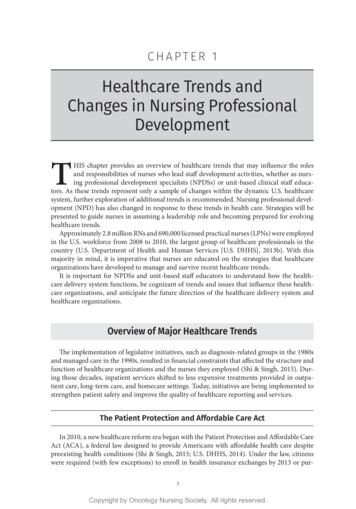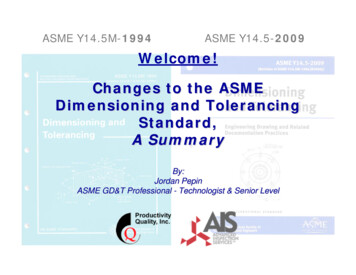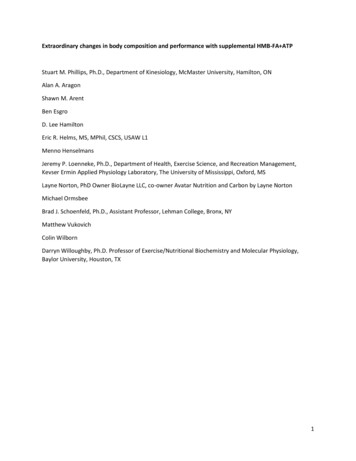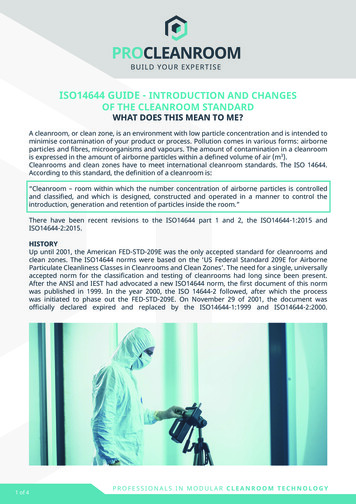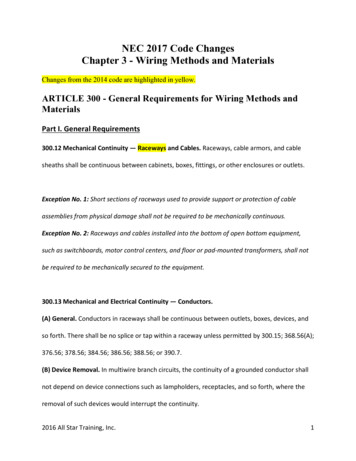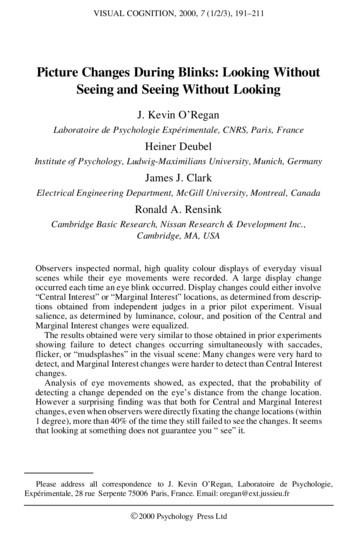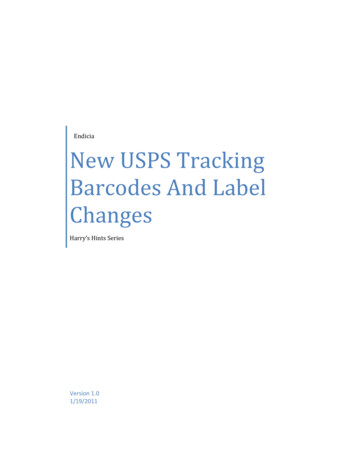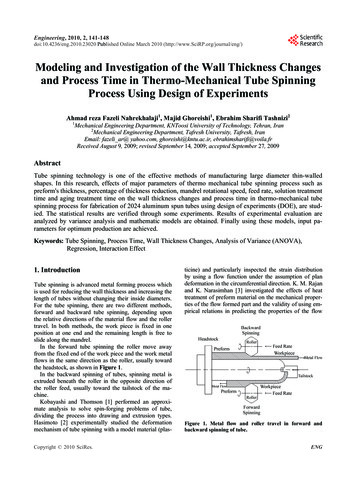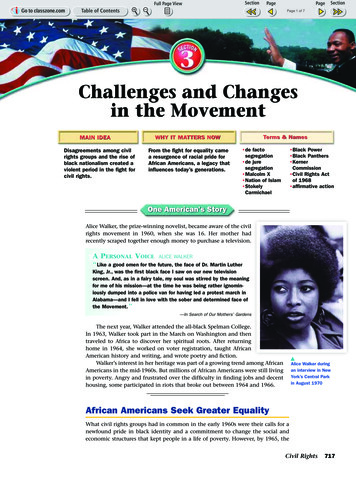
Transcription
10/21/025:51 PMPage 717Page 1 of 7Challenges and Changesin the MovementMAIN IDEADisagreements among civilrights groups and the rise ofblack nationalism created aviolent period in the fight forcivil rights.Terms & NamesWHY IT MATTERS NOWFrom the fight for equality camea resurgence of racial pride forAfrican Americans, a legacy thatinfluences today’s generations. de factosegregation de juresegregation Malcolm X Nation of Islam StokelyCarmichael Black Power Black Panthers KernerCommission Civil Rights Actof 1968 affirmative actionOne American's StoryAlice Walker, the prize-winning novelist, became aware of the civilrights movement in 1960, when she was 16. Her mother hadrecently scraped together enough money to purchase a television.A PERSONAL VOICE ALICE WALKER“ Like a good omen for the future, the face of Dr. Martin LutherKing, Jr., was the first black face I saw on our new televisionscreen. And, as in a fairy tale, my soul was stirred by the meaningfor me of his mission—at the time he was being rather ignominiously dumped into a police van for having led a protest march inAlabama—and I fell in love with the sober and determined face ofthe Movement.”—In Search of Our Mothers’ GardensThe next year, Walker attended the all-black Spelman College.In 1963, Walker took part in the March on Washington and thentraveled to Africa to discover her spiritual roots. After returninghome in 1964, she worked on voter registration, taught AfricanAmerican history and writing, and wrote poetry and fiction.Walker’s interest in her heritage was part of a growing trend among AfricanAmericans in the mid-1960s. But millions of African Americans were still livingin poverty. Angry and frustrated over the difficulty in finding jobs and decenthousing, some participated in riots that broke out between 1964 and 1966. 717-723-Chapter 21Alice Walker duringan interview in NewYork’s Central Parkin August 1970African Americans Seek Greater EqualityWhat civil rights groups had in common in the early 1960s were their calls for anewfound pride in black identity and a commitment to change the social andeconomic structures that kept people in a life of poverty. However, by 1965, theCivil Rights717
717-723-Chapter 2110/21/025:51 PMPage 718Page 2 of 7leading civil rights groups began to drift apart. New leaders emerged as the movement turned its attention to the North, where African Americans faced not legalsegregation but deeply entrenched and oppressive racial prejudice.NORTHERN SEGREGATION The problem facing African Americans in the Northwas de facto segregation—segregation that exists by practice and custom. Defacto segregation can be harder to fight than de jure (dC jMrPC) segregation, orsegregation by law, because eliminating it requires changing people’s attitudesrather than repealing laws. Activists in the mid-1960s would find it much more difficult to convince whites to share economic and social power with AfricanAmericans than to convince them to share lunch counters and bus seats. ADe facto segregation intensified after African Americans migrated to Northerncities during and after World War II. This began a “white flight,” in which greatnumbers of whites moved out of the cities to the nearby suburbs. By the mid1960s, most urban African Americans lived in decaying slums, paying rent to landlords who didn’t comply with housing and health ordinances. The schools forAfrican-American children deteriorated along with their neighborhoods.Unemployment rates were more than twice as high as those among whites.In addition, many blacks were angry at the sometimes brutal treatment theyreceived from the mostly white police forces in their communities. In 1966, Kingspearheaded a campaign in Chicago to end de facto segregation there and create an “open city.” On July 10, he ledabout 30,000 African Americans in a march on City Hall.In late July, when King led demonstrators through aChicago neighborhood, angry whites threw rocks andbottles. On August 5, hostile whites stoned King as he led600 marchers. King left Chicago without accomplishingwhat he wanted, yet pledging to return.URBAN VIOLENCE ERUPTS In the mid 1960s, clashesbetween white authority and black civilians spread likewildfire. In New York City in July 1964, an encounterbetween white police and African-American teenagersended in the death of a 15-year-old student. This sparkeda race riot in central Harlem. On August 11, 1965, onlyfive days after President Johnson signed the VotingBetween 1964 and1968, more than 100race riots erupted inmajor Americancities. The worstincluded Watts in LosAngeles in 1965(top) and Detroit in1967 (right). InDetroit, 43 peoplewere killed andproperty damagetopped 40 million.718CHAPTER 21MAIN IDEAComparingA How were civilrights problems inNorthern citiessimilar to those inthe South?A. AnswerBoth Northernand Southernblacks experienced povertyand inferiorschools, andtheir civil rightsdemands weremet with whiteanger and violence and policebrutality.
717-723-Chapter 2110/21/02MAIN IDEAAnalyzingCausesB What weresome of thecauses of urbanrioting in the1960s?B. AnswersDe facto segregation, policebrutality, rundown communities and schools,and high unemployment.5:51 PMPage 719Page 3 of 7Rights Act into law, one of the worst race riots in the nation’shistory raged through the streets of Watts, a predominantlyAfrican-American neighborhood in Los Angeles. Thirty-fourpeople were killed, and hundreds of millions of dollars worthof property was destroyed. The next year, 1966, saw evenmore racial disturbances, and in 1967 alone, riots and violentclashes took place in more than 100 cities.The African-American rage baffled many whites. “Whywould blacks turn to violence after winning so many victoriesin the South?” they wondered. Some realized that whatAfrican Americans wanted and needed was economic equality of opportunity in jobs, housing, and education. BEven before the riots in 1964, President Johnson hadannounced his War on Poverty, a program to help impoverished Americans. But the flow of money needed to fundJohnson’s Great Society was soon redirected to fund the warin Vietnam. In 1967, Dr. King proclaimed, “The Great Societyhas been shot down on the battlefields of Vietnam.”New Leaders Voice DiscontentThe anger that sent rioters into the streets stemmed in partfrom African-American leaders who urged their followers totake complete control of their communities, livelihoods, andculture. One such leader, Malcolm X, declared to a Harlemaudience, “If you think we are here to tell you to love thewhite man, you have come to the wrong place.”BackgroundSee “Islam” onpage 9.C. AnswerHe blamed blackpoverty andsocial inferiorityon whites andadvocatedarmed resistance to whiteoppression.MAIN IDEASynthesizingC Why did someAmericans findMalcolm X’s viewsalarming?AFRICAN-AMERICAN SOLIDARITY Malcolm X, bornMalcolm Little, went to jail at age 20 for burglary. While inprison, he studied the teachings of Elijah Muhammad, thehead of the Nation of Islam, or the Black Muslims. Malcolmchanged his name to Malcolm X (dropping what he called his“slave name”) and, after his release from prison in 1952,became an Islamic minister. As he gained a following, the brilliant thinker and engaging speaker openly preached ElijahMuhammad’s views that whites were the cause of the blackcondition and that blacks should separate from white society.Malcolm’s message appealed to many African Americansand their growing racial pride. At a New York press conferencein March 1964, he also advocated armed self-defense.KEY PLAYERMALCOLM X1925–1965Malcolm X’s early life left himalienated from white society. Hisfather was allegedly killed bywhite racists, and his mother hadan emotional collapse, leavingMalcolm and his siblings in thecare of the state. At the end ofeighth grade, Malcolm quit schooland was later jailed for criminalbehavior. In 1946, while in prison,Malcolm joined the Nation ofIslam. He developed a philosophyof black superiority and separatism from whites.In the later years of his life, heurged African Americans to identify with Africa and to work withworld organizations and even progressive whites to attain equality.Although silenced by gunmen,Malcolm X is a continuing inspiration for many Americans.A PERSONAL VOICE MALCOLM X“ Concerning nonviolence: it is criminal to teach a man not to defend himselfwhen he is the constant victim of brutal attacks. It is legal and lawful to own ashotgun or a rifle. We believe in obeying the law. . . . [T]he time has come for theAmerican Negro to fight back in self-defense whenever and wherever he is beingunjustly and unlawfully attacked.”—quoted in Eyewitness: The Negro in American HistoryThe press gave a great deal of publicity to Malcolm X because his controversial statements made dramatic news stories. This had two effects. First, his call forarmed self-defense frightened most whites and many moderate AfricanAmericans. Second, reports of the attention Malcolm received awakened resentment in some other members of the Nation of Islam. CCivil Rights719
717-723-Chapter 2110/21/025:51 PMPage 720Page 4 of 7BALLOTS OR BULLETS? In March 1964, Malcolm broke with Elijah Muhammadover differences in strategy and doctrine and formed another Muslim organization. One month later, he embarked on a pilgrimage to Mecca, in Saudi Arabia, atrip required of followers of orthodox Islam. In Mecca, he learned that orthodoxIslam preached racial equality, and he worshiped alongside people from manycountries. Wrote Malcolm, “I have [prayed] . . . with fellow Muslims whose eyeswere the bluest of blue, whose hair was the blondest of blond, and whose skin wasthe whitest of white.” When he returned to the United States, his attitude towardwhites had changed radically. He explained his new slogan, “Ballots or bullets,”to a follower: “Well, if you and I don’t use the ballot, we’re going to be forced touse the bullet. So let us try the ballot.”Because of his split with the Black Muslims, Malcolm believed his life might bein danger. “No one can get out without trouble,” he confided. On February 21, 1965,while giving a speech in Harlem, the 39-year-old Malcolm X was shot and killed.BLACK POWER In early June of 1966, tensions that had been building betweenSNCC and the other civil rights groups finally erupted in Mississippi. Here, JamesMeredith, the man who had integrated the University of Mississippi, set out on a225-mile “walk against fear.” Meredith planned to walk all the way from theTennessee border to Jackson, but he was shot by a white racist and was too injuredto continue.Martin Luther King, Jr., of the SCLC, Floyd McKissick of CORE, and StokelyCarmichael of SNCC decided to lead their followers in a march to finish whatMeredith had started. But it soon became apparent that SNCC and CORE memberswere quite militant, as they began to shout slogans similar to those of the black separatists who had followed Malcolm X. When King tried to rally the marchers withthe refrain of “We Shall Overcome,” many SNCC workers—bitter over the violencethey’d suffered during Freedom Summer—began singing, “We shall overrun.”Police in Greenwood, Mississippi, arrested Carmichael for setting up a tent onthe grounds of an all-black high school. When Carmichael showed up at a rallylater, his face swollen from a beating, he electrified the crowd.StokelyCarmichael(1968).The slogan “BlackPower” becamethe battle-cry ofmilitant civilrights activists. A PERSONAL VOICE STOKELY CARMICHAEL“ This is the twenty-seventh time I have been arrested—and I ain’t goingto jail no more! . . . We been saying freedom for six years—and we ain’tgot nothin’. What we’re gonna start saying now is BLACK POWER.”—quoted in The Civil Rights Movement: An Eyewitness HistoryBlack Power, Carmichael said, was a “call for black people to begin todefine their own goals . . . [and] to lead their own organizations.” Kingurged him to stop using the phrase because he believed it would provokeAfrican Americans to violence and antagonize whites. Carmichaelrefused and urged SNCC to stop recruiting whites and tofocus on developing African-American pride. DBLACK PANTHERS Later that year, another developmentdemonstrated the growing radicalism of some segments ofthe African-American community. In Oakland, California,in October 1966, Huey Newton and Bobby Seale foundeda political party known as the Black Panthers to fightpolice brutality in the ghetto. The party advocated selfsufficiency for African-American communities, as well asfull employment and decent housing. Members maintained that African Americans should be exempt from military service because an unfair number of black youths hadbeen drafted to serve in Vietnam.720D. AnswerSNCC leadersworried thatcalls for BlackPower wouldprovoke blackviolence andalienate whites.MAIN IDEAAnalyzingMotivesD Why did someleaders of SNCCdisagree withSCLC tactics?
717-723-Chapter 2110/21/02MAIN IDEAMakingInferencesE Why was thepublic reaction tothe Black Panthersmixed?E. AnswerAmericansfeared the BlackPanther’srhetoric andtheir involvement in violence; somepoor AfricanAmericans benefited from theircommunity programs.5:51 PMPage 721Page 5 of 7Dressed in black leather jackets, black berets, and sunglasses, the Pantherspreached self-defense and sold copies of the writings of Mao Zedong, leader of theChinese Communist revolution. Several police shootouts occurred between thePanthers and police, and the FBI conducted numerous investigations of group members (sometimes using illegal tactics). Even so, many of the Panthers’ activities—theestablishment of daycare centers, free breakfast programs, free medical clinics, assistance to the homeless, and other services—won support in the ghettos. E1968—A Turning Pointin Civil RightsMartin Luther King, Jr., objected to the Black Powermovement. He believed that preaching violence couldonly end in grief. King was planning to lead a PoorPeople’s March on Washington, D.C. However, thistime the people would have to march without him.KING’S DEATH Dr. King seemed to sense thatdeath was near. On April 3, 1968, he addressed acrowd in Memphis, where he had gone to supportthe city’s striking garbage workers. “I may not getthere with you but . . . we as a people will get to thePromised Land.” He added, “I’m not fearing anyman. Mine eyes have seen the glory of the comingof the Lord.” The next day as King stood on hishotel balcony, James Earl Ray thrust a high-poweredrifle out of a window and squeezed the trigger. Kingcrumpled to the floor.REACTIONS TO KING’S DEATH The night Kingdied, Robert F. Kennedy was campaigning for theDemocratic presidential nomination. Fearful thatKing’s death would spark riots, Kennedy’s adviserstold him to cancel his appearance in an AfricanAmerican neighborhood in Indianapolis. However,Kennedy attended anyway, making an impassionedplea for nonviolence.(above) Coretta Scott King mournsher husband at his funeral service.(below) Robert F. KennedyA PERSONAL VOICE ROBERT F. KENNEDY“ For those of you who are black—considering the evidenceVocabularypolarization:separation intoopposite camps. . . that there were white people who were responsible—youcan be filled with bitterness, with hatred, and a desire for revenge. We can move in that direction as a country, in greatpolarization—black people amongst black, white peopleamongst white, filled with hatred toward one another.Or we can make an effort, as Martin Luther King did, tounderstand and comprehend, and to replace that violence,that stain of bloodshed that has spread across our land, withan effort to understand [with] compassion and love.”—“A Eulogy for Dr. Martin Luther King, Jr.”Despite Kennedy’s plea, rage over King’s death led to the worst urban riotingin United States history. Over 100 cities exploded in flames. The hardest-hit citiesincluded Baltimore, Chicago, Kansas City, and Washington, D.C. Then in June1968, Robert Kennedy himself was assassinated by a Jordanian immigrant whowas angry over Kennedy’s support of Israel.Civil Rights721
717-723-Chapter 2110/21/025:51 PMPage 722Page 6 of 7Legacy of the Civil Rights MovementOn March 1, 1968, the Kerner Commission, which President Johnson hadappointed to study the causes of urban violence, issued its 200,000-word report. Init, the panel named one main cause: white racism. Said the report: “This is our basicconclusion: Our nation is moving toward two societies, one black, one white—separate and unequal.” The report called for the nation to create new jobs, construct newhousing, and end de facto segregation in order to wipe out the destructive ghettoenvironment. However, the Johnson administration ignored many of the recommendations because of white opposition to such sweeping changes. So what had thecivil rights movement accomplished?CIVIL RIGHTS GAINS The civil rights movement ended de jure segregation bybringing about legal protection for the civil rights of all Americans. Congresspassed the most important civil rights legislation since Reconstruction, includingthe Civil Rights Act of 1968, which ended discrimination in housing. Afterschool segregation ended, the numbers of African Americanswho finished high school and who went to college increasedHISTORICALsignificantly. This in turn led to better jobs and businessopportunities.Another accomplishment of the civil rights movementwas to give African Americans greater pride in their racialidentity. Many African Americans adopted African-influencedstyles and proudly displayed symbols of African history andculture. College students demanded new Black Studies programs so they could study African-American history and literature. In the entertainment world, the “color bar” was loweredas African Americans began to appear more frequently inmovies and on television shows and commercials.In addition, African Americans made substantial politicalgains. By 1970, an estimated two-thirds of eligible AfricanAmericans were registered to vote, and a significant increasein African-American elected officials resulted. The number ofAfrican Americans holding elected office grew from fewerthan 100 in 1965 to more than 7,000 in 1992. Many civilSHIRLEY CHISHOLMrights activists went on to become political leaders, amongAfrican-American women such asShirley Chisholm exemplified thethem Reverend Jesse Jackson, who sought the Democraticadvances won in the civil rightsnomination for president in 1984 and 1988; Vernon Jordan,movement. In 1968, Chisholmwho led voter-registration drives that enrolled about 2 millionbecame the first African-AmericanAfrican Americans; and Andrew Young, who has served as UNwoman in the United Statesambassador and Atlanta’s mayor. FHouse of Representatives.S P O TLIG H TIn the mid-1960s, Chisholmserved in the New York stateassembly, representing a districtin New York City. While there, shesupported programs to establishpublic day-care centers and provide unemployment insurance todomestic workers.In 1972, Chisholm gainednational prominence by runningfor the Democratic presidentialnomination. Despite the fact thatshe never won more than 10% ofthe vote in the primaries, shecontrolled 152 delegates at theDemocratic convention in Miami.722CHAPTER 21UNFINISHED WORK The civil rights movement was successful in changing many discriminatory laws. Yet as the1960s turned to the 1970s, the challenges for the movementchanged. The issues it confronted—housing and job discrimination, educational inequality, poverty, and racism—involved the difficult task of changing people’s attitudes andbehavior. Some of the proposed solutions, such as more taxmonies spent in the inner cities and the forced busing ofschoolchildren, angered some whites, who resisted furtherchanges. Public support for the civil rights movementdeclined because some whites were frightened by the urbanriots and the Black Panthers.By 1990, the trend of whites fleeing the cities for thesuburbs had reversed much of the progress toward schoolF. AnswerEnd of legalizedsegregation;constitutionala
African Americans, a legacy that influences today’s generations. Alice Walker, the prize-winning novelist, became aware of the civil rights movement in 1960, when she was 16. Her mother had recently scraped together enough money to purchase a television. A PERSONAL VOICE ALICE WAL
